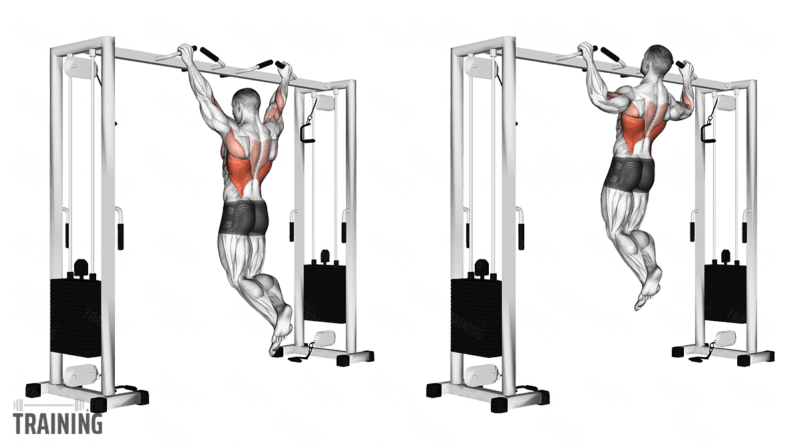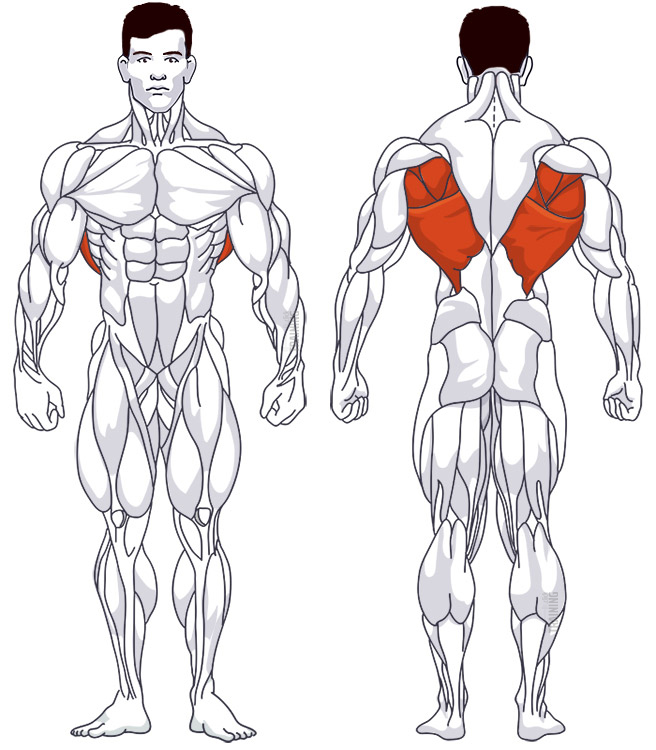Pull-Ups
Compound exercise, Body weightOverview

Main muscles
- Back: Large round muscle
(Musculus teres major) - Back: Large back muscle
(Musculus latissimus dorsi) - Back: Larger rhomboid muscle
(Musculus rhomboideus major) - Back: Small round muscle
(Musculus teres minor)
Training plans
Here you can find example plans for pull-ups training:
Pull-Ups: Basics and alternatives

Involved main muscle groups:
Pull-Ups
Pull-ups are a classic and versatile exercise with a long history in strength and endurance training. You probably already know the basic movement: hanging from a bar with both arms and pulling your body up until your head is above the bar.
There’s more than one way to do pull-ups. While we’ll describe the overhand grip version here, you can also perform the exercise with a wide grip, underhand grip, hammer grip, or behind the neck.
For beginners, training on a machine can be helpful. Alternatively, they can start with other upper back exercises to build strength before attempting pull-ups.
Regardless of the grip width and technique, pull-ups primarily target the back, especially the lats (latissimus dorsi muscle). They also engage the shoulders, biceps, forearms, chest, and neck to varying degrees. Since many muscle groups are involved, pull-ups are considered an essential exercise for any workout routine.
You can even perform pull-ups at home, provided you invest in a pull-up bar. Just make sure your wall or door frame is sturdy enough to support it.
Correct execution
Pull-ups are typically recommended and performed with an overhand grip, as it provides the best stimulation for the back muscles. Underhand grip pull-ups are often seen as easier because the biceps help out more, but that’s not necessarily a bad thing. The right grip technique depends on your training goals.
Besides grip, you can also vary the movement during pull-ups. You can keep your upper body straight or consciously stick out your chest and form a strong hollow back. In bodybuilding, a straight back posture is generally advised.
Pull-ups can be done as bodyweight exercises or with added weight. Only add weight when you can perform multiple sets of 8-12 reps with proper form. To add weight, you can use a dip belt, a weighted vest, or even a backpack filled with water bottles for home training.
Video tutorial
Step-by-step instructions
Stand under the pull-up bar and grab it slightly wider than shoulder-width with both hands in an overhand grip (back of hand facing you).
Bend your legs a bit and let yourself hang from the bar.
Pull your shoulder blades together.
Now use your arms and back muscles to pull your body up until your chin is level with the bar.
Slowly lower your body back down to the hanging starting position in a controlled manner.
Common mistakes
The most common mistake is swinging with your legs or whole body, which makes it easier to pull up but reduces the training effect significantly. Also, the resulting rocking motion puts more strain on the shoulders than performing the exercise in a controlled manner.
Make sure to perform the movement thoroughly with each repetition. Raise and lower your body far enough without cutting the movement short to make it easier.
When lowering, don’t let your body drop suddenly, as this puts unnecessary strain on your joints. Additionally, ensure that you perform the exercise evenly, lifting your body to the same degree on both the left and right sides. This helps to prevent imbalances and promotes proper form throughout the movement.